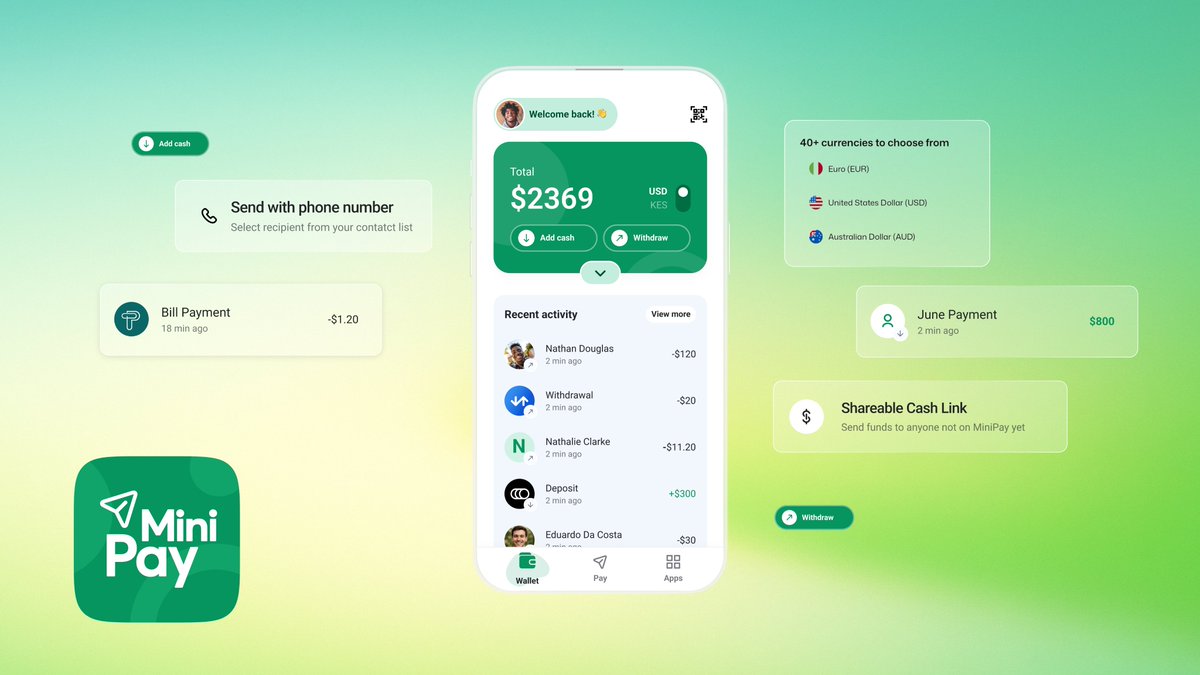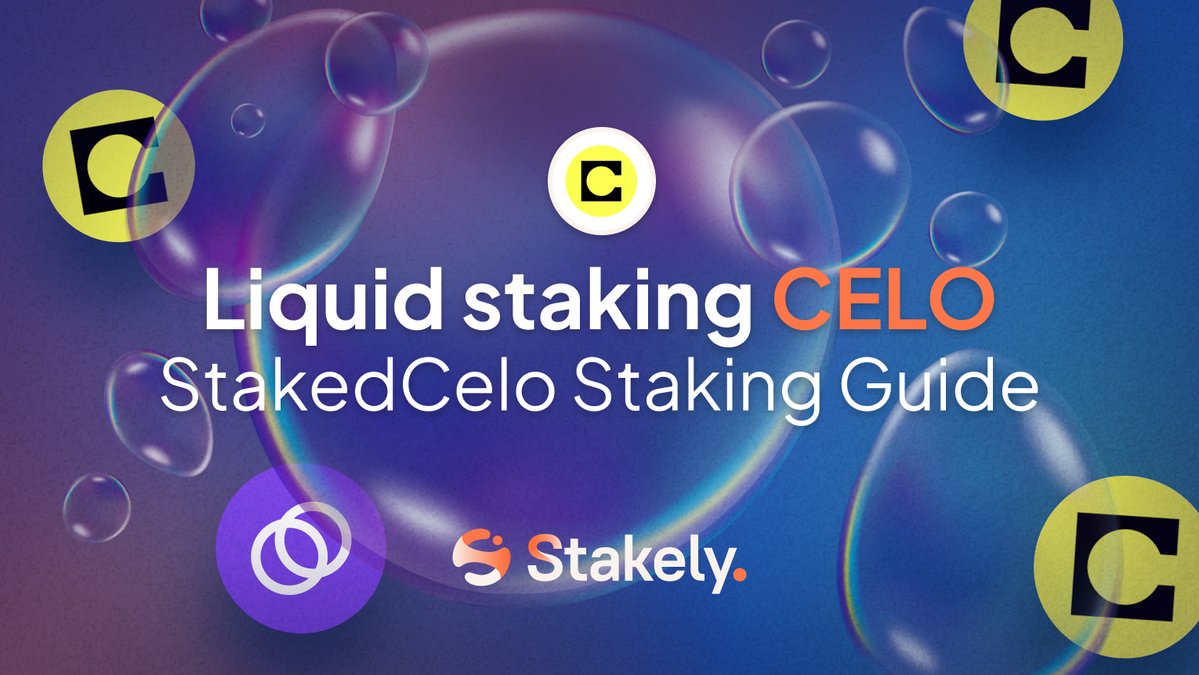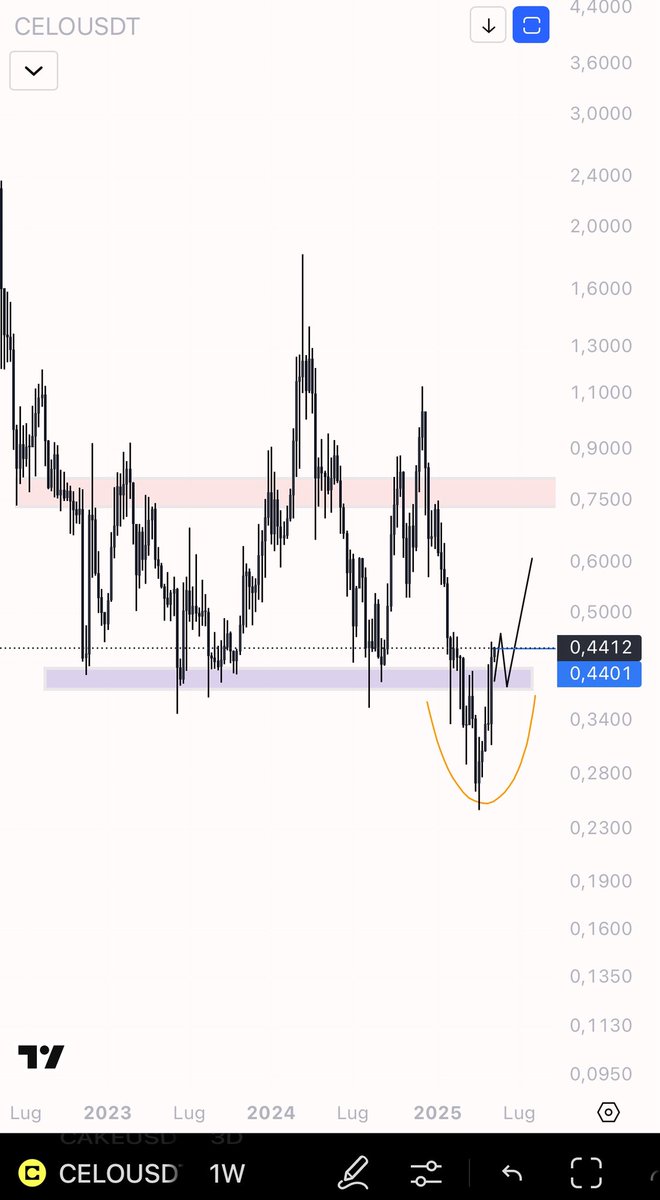
CELO
Celo-pris
$0,43100
-$0,02200
(−4,86 %)
Prisförändring de senaste 24 timmarna

Hur känner du för CELO idag?
Dela dina känslor här genom att göra tummen upp om du känner dig bullish för coin eller tummen ner om du känner dig bearish.
Rösta för att visa resultat
Friskrivningsklausul
Det sociala innehållet på den här sidan ("Innehållet"), inklusive men inte begränsat till tweets och statistik som tillhandahålls av LunarCrush, kommer från tredje part och tillhandahålls " i befintligt skick" och endast i informationssyfte. OKX garanterar inte innehållets kvalitet eller sanningshalt, och innehållet representerar inte OKX:s åsikter. Det är inte avsett att tillhandahålla (i) investeringsrådgivning eller -rekommendationer; (ii) ett erbjudande eller en uppmaning att köpa, sälja eller inneha digitala tillgångar; eller (iii) finansiell, redovisnings-, juridisk eller skatterådgivning. Digitala tillgångar, inklusive stabil kryptovaluta och NFT:er, innebär en hög grad av risk och kan fluktuera kraftigt. Priset och prestandan för den digitala tillgången är inte garanterade och kan ändras utan föregående meddelande.<br>OKX tillhandahåller inga rekommendationer om investeringar eller tillgångar. Du bör noga överväga om handel eller innehav av digitala tillgångar är lämpligt för dig, med tanke på din ekonomiska situation. Vänligen rådfråga en juridisk-/skatte-/investeringsrådgivare för frågor om just dina specifika omständigheter. För mer information, vänligen se våra <a href="/help/terms-of-service">Användarvillkor</a> och <a href="/help/risk-compliance-disclosure">Riskvarning</a>. Genom att använda tredjepartswebbplatsen (”third-party website/TPW”) godkänner du att all användning av TPW kommer att omfattas av och regleras av villkoren i TPW. Om inte annat uttryckligen anges skriftligen är OKX och dess dotterbolag ( OKX ) inte på något sätt associerade med ägaren eller operatören av TPW. Du samtycker till att OKX inte är ansvarigt eller skyldigt för någon förlust, skada eller andra konsekvenser som uppstår på grund av din användning av TPW. Vänligen observera om att användning av en TPW kan resultera i förlust eller minskning av dina tillgångar. Produkten kanske inte är tillgänglig i alla jurisdiktioner.
Celo marknadsinfo
Marknadsvärde
Marknadsvärde beräknas genom att multiplicera det cirkulerande utbudet av ett coin med dess senaste pris.
Börsvärde = Cirkulerande utbud × Senaste pris
Börsvärde = Cirkulerande utbud × Senaste pris
Cirkulerande utbud
Totalt belopp för ett coin som är allmänt tillgängligt på marknaden.
Marknadsvärde-rankning
Ett coins rankning i termer av marknadsvärde.
Högsta någonsin
Högsta pris ett coin har nått i sin handelshistorik.
Lägsta någonsin
Lägsta pris ett coin har nått i sin handelshistorik.
Marknadsvärde
$246,46M
Cirkulerande utbud
570 648 764 CELO
57,06 % av
1 000 000 000 CELO
Marknadsvärde-rankning
128
Granskningar

Senaste granskningen: 26 sep. 2022
Högsta priset under 24 tim
$0,45800
Lägsta priset under 24 tim
$0,42400
Högsta någonsin
$10,6260
−95,95 % (-$10,1950)
Senast uppdaterad: 30 aug. 2021
Lägsta någonsin
$0,24670
+74,70 % (+$0,18430)
Senast uppdaterad: 7 apr. 2025
Celo-flödet
Följande innehåll är hämtat från .

mareko.eth | Celo L2 🦇🌳
Wen iOS MiniPay? Nu iOS MiniPay!!

MiniPay
MiniPay är nu live som en fristående app för iOS och Android!
🌏 Omdefiniera globala betalningar med en stablecoin-plånbok för verklig användning.
Nu tillgängligt i 50+ länder:
Icke-frihetsberövande. Omedelbara överföringar för <$0,01. Byggd på @Celo. Stöder USDT, cUSD och USDC.

16,18 tn
21

Celo.eth/acc 🦇 🌳
Detta bara i: @MiniPay fristående app är tillgänglig för iOS- och Android-användare i 50+ länder! 📲
Globala användare utnyttjar nu den icke-förvarande stablecoin-plånboken för att spendera, spara och skicka med USDT, USDC och cUSD och få tillgång till det snabbt växande ekosystemet 🌐 för miniappar
🧵 Läs mer↓
26,98 tn
69

Celo.eth/acc 🦇 🌳 delade inlägget

Rene | Celo ◘ 🦇🌳
Har aldrig varit en bättre tid att vara byggare
@minipay på @celo hjälper miniappar som BlockScratch att snabbt växa stora engagerade användarbaser, med inbyggd onchain-betalning och identitetsskenor
Början på en ny era

Blockscratch 👾
Under det senaste året är vi så glada över att ha arbetat med @minipay att ha fått över 300,000 användare som kommer in varje månad för att söka glädje på Blockscratch 🪄
Till många fler år av gediget samarbete tillsammans!
12,26 tn
35

Stakely
🎥 Hur man likvid stake @Celo på StakedCelo -
När du satsar $CELO får du $stCELO, en token som ökar i värde i förhållande till dina insatta $CELO i takt med att insatsbelöningarna ackumuleras. Dessutom kan du använda $stCELO i DeFi-protokoll för att tjäna ytterligare avkastning 💛
Upptäck hur du kan sätta ut $CELO med flytande stakning i 3 enkla steg ⬇️
🔗
Visa original
18,39 tn
3
CELO-kalkylator


Celo prisutveckling i USD
Aktuellt pris på Celo är $0,43100. Under de senaste 24 timmarna har Celo minskade med −4,86 %. Det har för närvarande ett cirkulerande utbud av 570 648 764 CELO och ett maximalt utbud av 1 000 000 000 CELO, vilket ger ett marknadsvärde efter full utspädning på $246,46M. För tillfället innehar Celo-coin position 128 i marknadsvärdesrankningar. Celo/USD-priset uppdateras i realtid.
Idag
-$0,02200
−4,86 %
7 dagar
+$0,10510
+32,24 %
30 dagar
+$0,13520
+45,70 %
3 månader
-$0,01980
−4,40 %
Populära Celo-omvandlingar
Senast uppdaterad: 2025-05-15 08:24
| 1 CELO till USD | 0,43190 $ |
| 1 CELO till EUR | 0,38626 € |
| 1 CELO till PHP | 24,1324 ₱ |
| 1 CELO till IDR | 7 153,03 Rp |
| 1 CELO till GBP | 0,32561 £ |
| 1 CELO till CAD | 0,60380 $ |
| 1 CELO till AED | 1,5864 AED |
| 1 CELO till VND | 11 203,63 ₫ |
Om Celo (CELO)
Betyget som anges är ett sammanställt betyg som inhämtats av OKX från källorna som anges, och det anges endast för informativa syften. OKX garanterar inte betygens kvalitet eller korrekthet. Det är inte avsett att utgöra (i) investeringsrådgivning eller rekommendation, (ii) ett erbjudande eller en uppmaning att köpa, sälja eller inneha digitala tillgångar, eller (iii) finansiell, redovisningsmässig, juridisk eller skattemässig rådgivning. Digitala tillgångar, inklusive stabil kryptovaluta och NFT:er, omfattas av hög risk, kan skifta kraftigt och till och med bli värdelösa. Priset och prestanda för de digitala tillgångarna garanteras inte, och de kan förändras utan föregående meddelande. Dina digitala tillgångar täcks inte av försäkran mot potentiella förluster. Historisk avkastning är ingen garanti om framtida avkastning. OKX garanterar inte någon avkastning, återbetalning av huvudbelopp eller ränta. OKX tillhandahåller inga rekommendationer om investeringar eller tillgångar. Du bör noga överväga om handel med eller innehav av digitala tillgångar är lämpligt för dig med hänsyn till din ekonomiska situation. Rådgör med din jurist, skatteexpert eller investeringsrådgivare om du har frågor om dina specifika omständigheter.
Visa mer
- Officiell webbplats
- Vitbok
- Github
- Block explorer
Om tredjeparts webbplatser
Om tredjeparts webbplatser
Genom att använda tredjepartswebbplatsen (”TPW”) samtycker du till att all användning av TPW kommer att omfattas av och styras av villkoren i TPW. Om inte annat uttryckligen anges skriftligen är OKX och dess affiliates (”OKX”) inte på något sätt associerade med ägaren eller operatören av TPW. Du samtycker till att OKX inte är ansvarigt eller skadeståndsskyldigt för förlust, skada eller andra konsekvenser som uppstår till följd av din användning av TPW. Var medveten om att användning av en TPW kan leda till förlust eller minskning av dina tillgångar.
Vanliga frågor för Celo
Hur mycket är 1 Celo värd idag?
För närvarande är en Celo värd $0,43100. För svar och insikt om prisåtgärder för Celo är du på rätt plats. Utforska de senaste diagrammen för Celo och handla ansvarsfullt med OKX.
Vad är kryptovalutor?
Kryptovalutor, till exempel Celo, är digitala tillgångar som fungerar på en offentlig reskontra som kallas blockkedjor. Läs mer om coins och tokens som erbjuds på OKX och deras olika attribut, som inkluderar live-priser och realtidsdiagram.
När uppfanns kryptovalutor?
Tack vare finanskrisen 2008 ökade intresset för decentraliserad finansiering. Bitcoin erbjöd en ny lösning genom att vara en säker digital tillgång på ett decentraliserat nätverk. Sedan dess har många andra tokens som t.ex. Celo skapats också.
Kommer priset på Celo gå upp idag?
Se vår Celo prisprognossida för att förutse framtida priser och fastställa dina prismål.
ESG-upplysning
ESG-regleringar (Environmental, Social och Governance) för kryptotillgångar syftar till att ta itu med eventuell miljöpåverkan (t.ex. energiintensiv mining), främja transparens och säkerställa etiska förvaltningsmetoder för att anpassa kryptoindustrin till bredare hållbarhets- och samhälleliga mål. Dessa regleringar uppmuntrar efterlevnad av standarder som minskar risker och främjar förtroende för digitala tillgångar.
Tillgångsdetaljer
Namn
OKcoin Europe LTD
Relevant juridisk enhetsidentifierare
54930069NLWEIGLHXU42
Namn på kryptotillgången
Celo
Konsensusmekanism
Celo is present on the following networks: celo, near_protocol.
Celo uses a Proof of Stake (PoS) consensus model, which supports a decentralized, community-driven approach to governance and network security. Core Components of Celo’s Consensus: 1. Proof of Stake (PoS): Validator Role: Validators are responsible for creating new blocks, validating transactions, and maintaining the security and integrity of the network. Validators are selected based on the amount of CELO tokens they hold and stake, incentivizing honest participation and network reliability. 2. Decentralized Governance: Community Voting: Governance on Celo is decentralized, allowing CELO token holders to vote on proposals and changes to the network. This community-driven approach ensures that token holders have a say in the network’s development and strategic direction.
The NEAR Protocol uses a unique consensus mechanism combining Proof of Stake (PoS) and a novel approach called Doomslug, which enables high efficiency, fast transaction processing, and secure finality in its operations. Here's an overview of how it works: Core Concepts 1. Doomslug and Proof of Stake: - NEAR's consensus mechanism primarily revolves around PoS, where validators stake NEAR tokens to participate in securing the network. However, NEAR's implementation is enhanced with the Doomslug protocol. - Doomslug allows the network to achieve fast block finality by requiring blocks to be confirmed in two stages. Validators propose blocks in the first step, and finalization occurs when two-thirds of validators approve the block, ensuring rapid transaction confirmation. 2. Sharding with Nightshade: - NEAR uses a dynamic sharding technique called Nightshade. This method splits the network into multiple shards, enabling parallel processing of transactions across the network, thus significantly increasing throughput. Each shard processes a portion of transactions, and the outcomes are merged into a single "snapshot" block. - This sharding approach ensures scalability, allowing the network to grow and handle increasing demand efficiently. Consensus Process 1. Validator Selection: - Validators are selected to propose and validate blocks based on the amount of NEAR tokens staked. This selection process is designed to ensure that only validators with significant stakes and community trust participate in securing the network. 2. Transaction Finality: - NEAR achieves transaction finality through its PoS-based system, where validators vote on blocks. Once two-thirds of validators approve a block, it reaches finality under Doomslug, meaning that no forks can alter the confirmed state. 3. Epochs and Rotation: - Validators are rotated in epochs to ensure fairness and decentralization. Epochs are intervals in which validators are reshuffled, and new block proposers are selected, ensuring a balance between performance and decentralization.
Incitamentmekanismer och tillämpliga avgifter
Celo is present on the following networks: celo, near_protocol.
Celo’s incentive model rewards validators and prioritizes accessibility with minimal transaction fees, especially for cross-border payments, supporting a flexible and user-friendly ecosystem. Incentive Mechanisms: 1. Validator Rewards: Transaction Fees and Newly Minted Tokens: Validators earn rewards from transaction fees as well as newly minted CELO tokens. This dual-source reward system provides a continuous financial incentive for validators to act honestly and secure the network. 2. Transaction Flexibility and Gas Price: Gas Limit and Price Control: Each transaction specifies a maximum gas limit, ensuring that users are not excessively charged if a transaction fails. Users can also set a gas price to prioritize transactions, allowing faster processing for higher fees. Payment Flexibility with Multiple Currencies: Unlike many blockchains, Celo allows transaction fees to be paid in various ERC-20 tokens, providing flexibility for users. This approach improves accessibility, especially for individuals with limited access to traditional banking. 3. Minimal Fee Structure for Accessibility: Designed for Low-Cost Transactions: Celo’s fee structure is intentionally minimal, particularly for cross-border payments, making it ideal for users who may not have traditional banking options. This focus on accessibility aligns with Celo’s mission to bring blockchain technology to underserved communities. Applicable Fees: • Transaction Fees: Fees are calculated based on gas usage, with a maximum gas limit set per transaction. This limit protects users from excessive costs, while the option to pay in multiple currencies enhances flexibility.
NEAR Protocol employs several economic mechanisms to secure the network and incentivize participation: Incentive Mechanisms to Secure Transactions: 1. Staking Rewards: Validators and delegators secure the network by staking NEAR tokens. Validators earn around 5% annual inflation, with 90% of newly minted tokens distributed as staking rewards. Validators propose blocks, validate transactions, and receive a share of these rewards based on their staked tokens. Delegators earn rewards proportional to their delegation, encouraging broad participation. 2. Delegation: Token holders can delegate their NEAR tokens to validators to increase the validator's stake and improve the chances of being selected to validate transactions. Delegators share in the validator's rewards based on their delegated tokens, incentivizing users to support reliable validators. 3. Slashing and Economic Penalties: Validators face penalties for malicious behavior, such as failing to validate correctly or acting dishonestly. The slashing mechanism enforces security by deducting a portion of their staked tokens, ensuring validators follow the network's best interests. 4. Epoch Rotation and Validator Selection: Validators are rotated regularly during epochs to ensure fairness and prevent centralization. Each epoch reshuffles validators, allowing the protocol to balance decentralization with performance. Fees on the NEAR Blockchain: 1. Transaction Fees: Users pay fees in NEAR tokens for transaction processing, which are burned to reduce the total circulating supply, introducing a potential deflationary effect over time. Validators also receive a portion of transaction fees as additional rewards, providing an ongoing incentive for network maintenance. 2. Storage Fees: NEAR Protocol charges storage fees based on the amount of blockchain storage consumed by accounts, contracts, and data. This requires users to hold NEAR tokens as a deposit proportional to their storage usage, ensuring the efficient use of network resources. 3. Redistribution and Burning: A portion of the transaction fees (burned NEAR tokens) reduces the overall supply, while the rest is distributed to validators as compensation for their work. The burning mechanism helps maintain long-term economic sustainability and potential value appreciation for NEAR holders. 4. Reserve Requirement: Users must maintain a minimum account balance and reserves for data storage, encouraging efficient use of resources and preventing spam attacks.
Början av den period som upplysningen avser
2024-04-20
Slutet av den period som upplysningen avser
2025-04-20
Energirapport
Energiförbrukning
39420.00000 (kWh/a)
Energiförbrukningskällor och -metoder
The energy consumption of this asset is aggregated across multiple components:
For the calculation of energy consumptions, the so called “bottom-up” approach is being used. The nodes are considered to be the central factor for the energy consumption of the network. These assumptions are made on the basis of empirical findings through the use of public information sites, open-source crawlers and crawlers developed in-house. The main determinants for estimating the hardware used within the network are the requirements for operating the client software. The energy consumption of the hardware devices was measured in certified test laboratories. When calculating the energy consumption, we used - if available - the Functionally Fungible Group Digital Token Identifier (FFG DTI) to determine all implementations of the asset of question in scope and we update the mappings regulary, based on data of the Digital Token Identifier Foundation.
To determine the energy consumption of a token, the energy consumption of the network(s) celo, near_protocol is calculated first. Based on the crypto asset's gas consumption per network, the share of the total consumption of the respective network that is assigned to this asset is defined. When calculating the energy consumption, we used - if available - the Functionally Fungible Group Digital Token Identifier (FFG DTI) to determine all implementations of the asset of question in scope and we update the mappings regulary, based on data of the Digital Token Identifier Foundation.
CELO-kalkylator


















Sociala medier